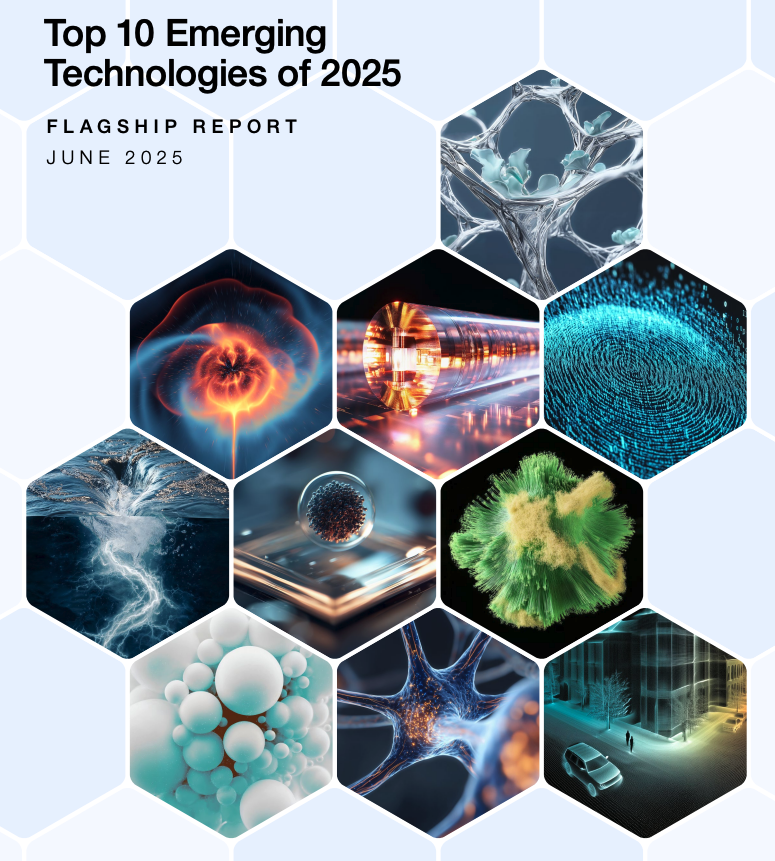What Is Emerging Technology?
The Top 10 Emerging Technologies of 2025 highlight transformative breakthroughs that will redefine industries and reshape our lives. These innovations span fields from clean energy to synthetic biology, offering solutions to some of the world’s biggest challenges. But what is emerging technology, exactly? It refers to newly developed tools or scientific discoveries that are not yet mainstream but are on the brink of global impact – technologies that could be game-changers within the next decade.
According to the World Economic Forum (WEF), emerging technologies must:
- Be novel or rapidly evolving
- Offer major economic or societal impact
- Be on a clear path to commercialization
- Lack widespread regulatory or infrastructural maturity
Let’s explore the Top 10 Emerging Technologies of 2025, each backed by research, pilot deployments, or commercial prototypes.
1. Structural Battery Composites
Sector: Energy Storage, Aerospace, Mobility
Use case: Electric vehicles (EVs) and drones often carry heavy batteries. Structural battery composites (SBCs) aim to make the car body itself store energy, reducing the need for separate packs.
Pilot program: Chalmers University’s SBCs achieved 24 Wh/kg in real-world tests, and researchers are collaborating with aerospace companies to design aircraft wings with integrated energy storage.
Commercial interest: Airbus and Volvo are actively studying integration for e-mobility and unmanned aircraft systems (UAS).
Impact: Vehicles become lighter, more energy-efficient, and possibly cheaper to manufacture.
Challenge: Stability under high-impact scenarios and fire safety regulations.
2. Osmotic Power Systems
Sector: Clean Energy, Water-Tech
Use case: Coastal cities and desalination plants can use salinity gradients between salt and freshwater to generate predictable, renewable energy.
Pilot program: REDstack in the Netherlands operates one of the world’s only operational osmotic pilot plants.
Commercial interest: Companies like Statkraft and Aquaporin are developing scalable membrane technologies.
Impact: Low-carbon, continuous power for island nations and cities with river-sea convergence.
Challenge: Cost-effective membranes and minimizing ecological disruption to estuarine zones.
3. Advanced Nuclear Technologies
Sector: Energy Infrastructure
Use case: Countries phasing out coal need stable baseload electricity. Small modular reactors (SMRs) are easier to site, cheaper to build, and safer by design.
Pilot program: Canada’s Darlington SMR project is expected online by 2029; the U.S. DOE has approved NuScale’s design for commercial deployment.
Commercial interest: Bill Gates’ TerraPower and Rolls-Royce are investing in next-gen reactor platforms.
Impact: Major contribution to climate-neutral energy goals.
Challenge: Public acceptance, complex regulatory approval, and long build times.
4. Engineered Living Therapeutics
Sector: Biotech, Pharma
Use case: Probiotic-style pills containing engineered microbes that release drugs directly inside the body, responding to biological cues.
Pilot program: Synlogic is running clinical trials on synthetic biotics for metabolic diseases.
Commercial interest: Companies like Ginkgo Bioworks and Intrexon are investing in living medicine platforms.
Impact: Enables dynamic, highly personalized treatments for chronic or rare diseases.
Challenge: Safety, patient consent, and FDA pathway clarity for live biological agents.
5. GLP-1s for Neurodegenerative Disease
Sector: Neuroscience, Therapeutics
Use case: GLP-1 receptor agonists (e.g. Ozempic, Wegovy) used for diabetes and obesity are showing neuroprotective effects in Alzheimer’s by reducing brain inflammation and improving metabolism.
Pilot program: Eli Lilly and Novo Nordisk are sponsoring trials examining GLP-1s in cognitive decline.
Commercial interest: Expected surge in off-label prescriptions as more neurological indications are studied.
Impact: Offers a pharmaceutical bridge between metabolic and neurodegenerative care.
Challenge: Ensuring long-term neurological benefit and affordability for neuro patients.
6. Autonomous Biochemical Sensing
Sector: Healthtech, Environment, Wearables
Use case: Smart patches and ingestible sensors that continuously monitor glucose, lactate, pH, or pollutants—without external power or batteries.
Pilot program: UC Berkeley’s “smart tattoo” skin sensor monitors sweat electrolytes in real-time.
Commercial interest: Abbott’s FreeStyle Libre and Google’s Verily are actively investing in closed-loop sensing systems.
Impact: Enables early disease detection, continuous diagnostics, and real-time pollution alerts.
Challenge: Data security, wear time, bio-compatibility.
7. Green Nitrogen Fixation
Sector: Agriculture, Fertilizer Tech, Hydrogen
Use case: Instead of relying on high-emission Haber-Bosch ammonia production, new systems fix atmospheric nitrogen using electricity or engineered bacteria.
Pilot program: The U.S. DOE’s REFuel project and startups like Nitricity are building plasma-based on-farm fertilizer systems.
Commercial interest: Bayer and Pivot Bio are backing microbial nitrogen-fixing platforms for corn and wheat.
Impact: Could reduce over 1.5% of global greenhouse gas emissions from agriculture.
Challenge: Field consistency, nitrogen yield, and soil interactions.
8. Nanozymes
Sector: Materials Science, Environmental Cleanup, Medical Diagnostics
Use case: Replace natural enzymes (expensive, fragile) with durable nanoscale catalysts that mimic or enhance enzymatic reactions.
Pilot program: Nanozyme-coated filters tested to degrade pesticides and pollutants in water in China and India.
Commercial interest: Used in rapid COVID-19 test kits for enhanced signal amplification.
Impact: Fast diagnostics, bio-remediation, smart coatings for industrial processes.
Challenge: Toxicity concerns and limited biological specificity.
9. Collaborative Sensing
Sector: Smart Cities, IoT, Autonomous Systems
Use case: Traffic systems, drones, weather sensors, and mobile phones share and interpret real-time data collectively using AI to make smarter decisions.
Pilot program: MIT’s Senseable City Lab deployed collaborative air-quality sensors across Boston.
Commercial interest: Tesla’s fleet learning is a working example of collaborative sensing at automotive scale.
Impact: Improves real-time decision-making across urban mobility, disaster response, and autonomous vehicles.
Challenge: Privacy, interoperability, and data fusion complexity.
10. Generative Watermarking
Sector: AI, Media, Cybersecurity
Use case: Embedding invisible identifiers into AI-generated images, audio, or text to prove authenticity or ownership.
Pilot program: OpenAI, Adobe, and Meta have formed the C2PA coalition to create global watermarking standards.
Commercial interest: Already implemented in Adobe Firefly and OpenAI’s Sora outputs.
Impact: Helps fight misinformation, deepfakes, and IP theft in the age of generative content.
Challenge: Watermark robustness, cross-platform adoption, circumvention risks.
Recap: Top Emerging Technology Sectors
Let’s revisit the top emerging technology sectors that unify these innovations:
| Sector | Technologies Impacting It |
|---|---|
| Energy & Climate | Structural Batteries, Osmotic Power, Advanced Nuclear, Green Nitrogen Fixation |
| Healthcare & Biotech | GLP-1s, Engineered Therapeutics, Nanozymes, Bio-sensing |
| AI & Digital Media | Generative Watermarking, Collaborative Sensing |
| Materials Science | Nanozymes, Structural Composites |
| Agriculture | Nitrogen Fixation, Autonomous Sensors |
Conclusion: 2025 Is the Pivot Point
From structural battery composites to generative watermarking, the Top 10 Emerging Technologies of 2025 represent a powerful convergence of science, sustainability, and software. These innovations aren’t just theoretical – they’re already being piloted, funded, and tested across industries, signaling a clear path toward commercialization.
Whether you’re a policymaker, investor, startup founder, or technologist, understanding the Top 10 Emerging Technologies of 2025 is critical to anticipating future disruptions, identifying high-growth sectors, and building resilient strategies in a rapidly evolving world.
“This year’s emerging technologies highlight the convergence of biology, computation, and sustainability—forming a new blueprint for the 21st-century economy.”
— World Economic Forum, 2025
Sources & References:
Posts of interest:


